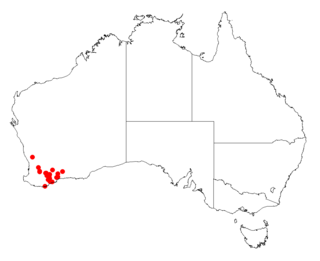
Acacia deanei is a tree native to Australia, which is useful for controlling soil erosion. There are two subspecies: Acacia deanei subsp. deanei and Acacia deanei subsp. paucijuga.

Acacia insolita is a shrub belonging to the genus Acacia and the subgenus Phyllodineae that is endemic to south western Australia.

Acacia polybotrya, commonly known the western silver wattle or the hairy feather wattle, is a shrub of the genus Acacia and the subgenus Botrycephalae. It is native to an area in New South Wales and Queensland.

Acacia amputata is a shrub of the genus Acacia and the subgenus Pulchellae that is endemic to an area of south western Australia.

Acacia depressa, also commonly known as echidna wattle, is a shrub of the genus Acacia and the subgenus Pulchellae that is endemic to south western Australia. It was listed as vulnerable according the Environment Protection and Biodiversity Conservation Act 1999 in 2007.

Acacia epacantha is a shrub of the genus Acacia and the subgenus Pulchellae that is endemic to an area in the south west of Australia.

Acacia fagonioides is a shrub of the genus Acacia and the subgenus Pulchellae that is endemic to an area of south western Australia.

Acacia grisea is a shrub of the genus Acacia and the subgenus Pulchellae that is endemic to an area of south western Australia.

Acacia guinetii, commonly known as Guinet's wattle, is a shrub of the genus Acacia and the subgenus Pulchellae that is endemic to a small area along the coast of western Australia

Acacia lateriticola is a shrub of the genus Acacia and the subgenus Pulchellae that is endemic to an area of south western Australia.

Acacia luteola is a shrub of the genus Acacia and the subgenus Pulchellae that is endemic to an area of south west Australia.

Acacia newbeyi is a shrub of the genus Acacia and the subgenus Pulchellae that is endemic to an area of south western Australia.

Acacia pentadenia, commonly known as karri wattle, is a shrub or tree of the genus Acacia and the subgenus Pulchellae.

Acacia preissiana is a shrub of the genus Acacia and the subgenus Pulchellae that is endemic to an area of south western Australia.

Acacia tayloriana is a shrub of the genus Acacia and the subgenus Pulchellae that is endemic to a small area of south western Australia

Acacia oshanesii, commonly known as corkwood wattle and irish wattle, is a species of Acacia native to eastern Australia.

Acacia mollifolia, commonly known as the hairy silver wattle, velvet acacia and hoary silver wattle is a species of Acacia native to eastern Australia.

Acacia kulnurensis, commonly known as the Kulnura wattle, is a species of Acacia native to eastern Australia.

Acacia loroloba, commonly known as the Ma Ma Creek wattle, is a species of Acacia native to eastern Australia.

Acacia storyi, commonly known as Story's wattle, is a species of Acacia of the subgenus Botrycephalae that is native to eastern Australia. It is listed as near threatened according to the Nature Conservation Act 1992 of Queensland.




















